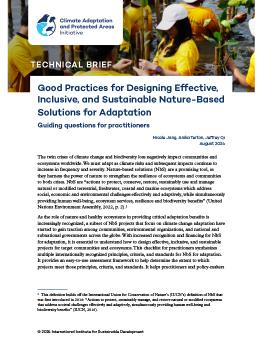
Good Practices for Designing Effective, Inclusive, and Sustainable Nature-Based Solutions for Adaptation
Guiding questions for practitioners
This report provides an easy-to-use framework for assessing nature-based solutions (NbS) for adaptation projects based on internationally recognized principles and standards. It aims to help practitioners and policy-makers assess whether their project follows good practices for gender-responsive, socially inclusive, and conflict-sensitive approaches to NbS for adaptation interventions.
The twin crises of climate change and biodiversity loss negatively impact communities and ecosystems worldwide. As the role of nature and healthy ecosystems in providing critical adaptation benefits is increasingly recognized, a subset of nature-based solutions (NbS) projects that focus on climate change adaptation have started to gain traction among communities, environmental organizations, and national and subnational governments across the globe. With increased recognition and financing for NbS for adaptation, it is essential to understand how to design effective, inclusive, and sustainable projects for target communities and ecosystems.
This checklist for practitioners synthesizes multiple internationally recognized principles, criteria, and standards for NbS for adaptation and provides an easy-to-use assessment framework to help determine the extent to which projects meet those benchmarks. It also helps practitioners and policy-makers design, evaluate, and implement adaptive management of NbS for adaptation projects and assists them in assessing whether their project follows good practices for gender-responsive, socially inclusive, and conflict-sensitive approaches to NbS for adaptation interventions.
This technical brief is a knowledge product of the Climate Adaptation and Protected Areas (CAPA) Initiative.
You might also be interested in
IISD Annual Report 2023–2024
While IISD's reputation as a convenor, a trusted thought leader, and a go-to source on key issues within the sustainable development field is stronger than ever, the work happening outside the spotlight is just as valuable.
How to Make Nature-Based Solutions for Adaptation Work for Everyone
Effective nature-based solutions (NbS) for adaptation start with integrated climate risk assessments. These take-aways will help practitioners plan for inclusive and sustainable NbS.
Inclusive Nature-Based Solutions for Climate Adaptation
Discover how climate change and biodiversity loss impact people differently and how inclusive nature-based solutions for adaptation can help.
Nature-Based Solutions Inventory for Fiji
This inventory showcases the variety of nature-based solutions (NbS) projects (both completed and ongoing) being implemented in Fiji's ecosystems.